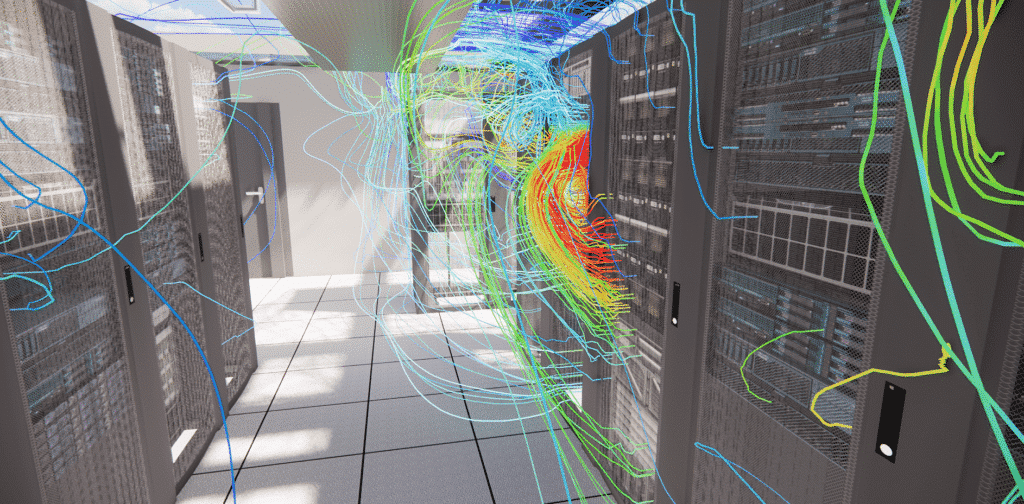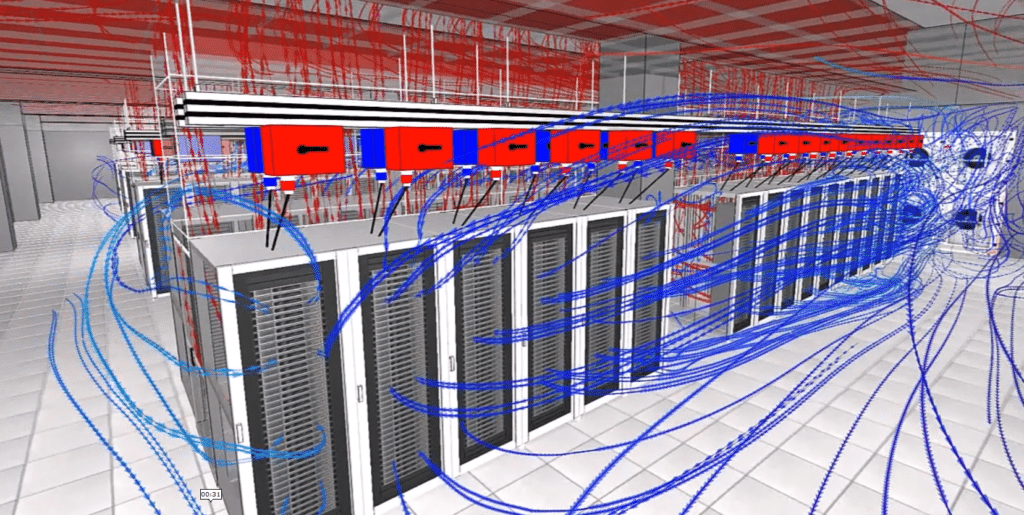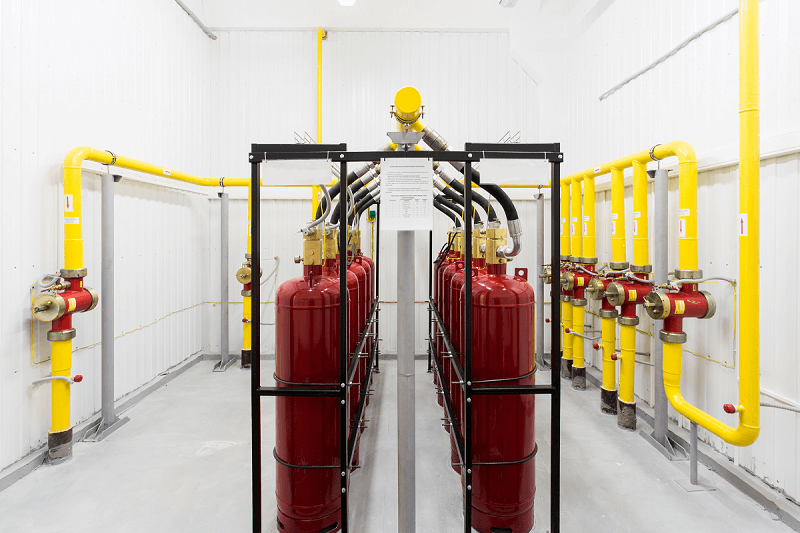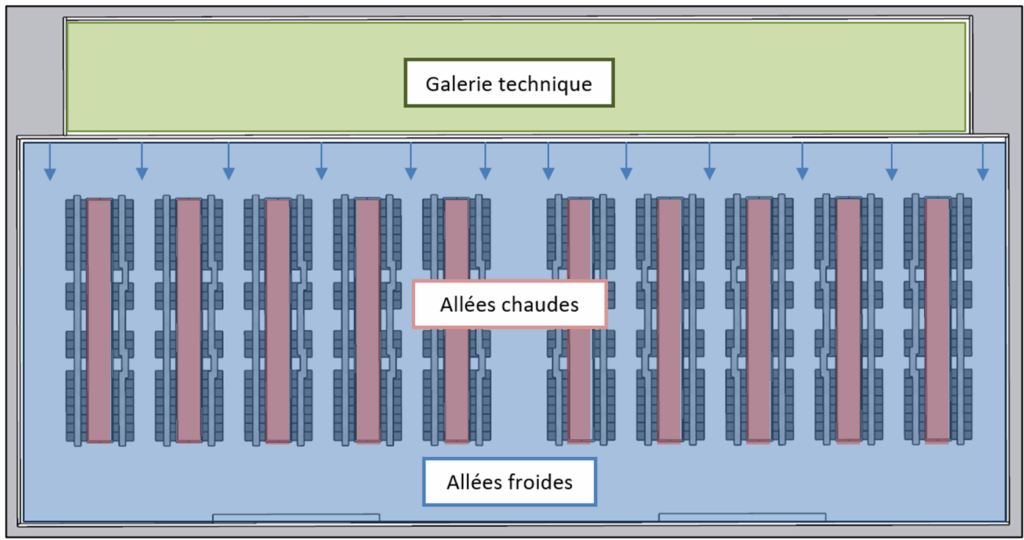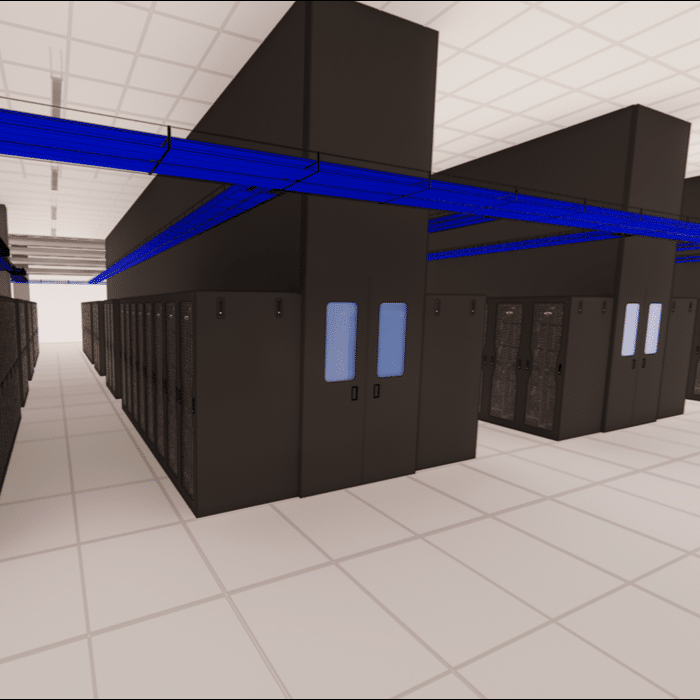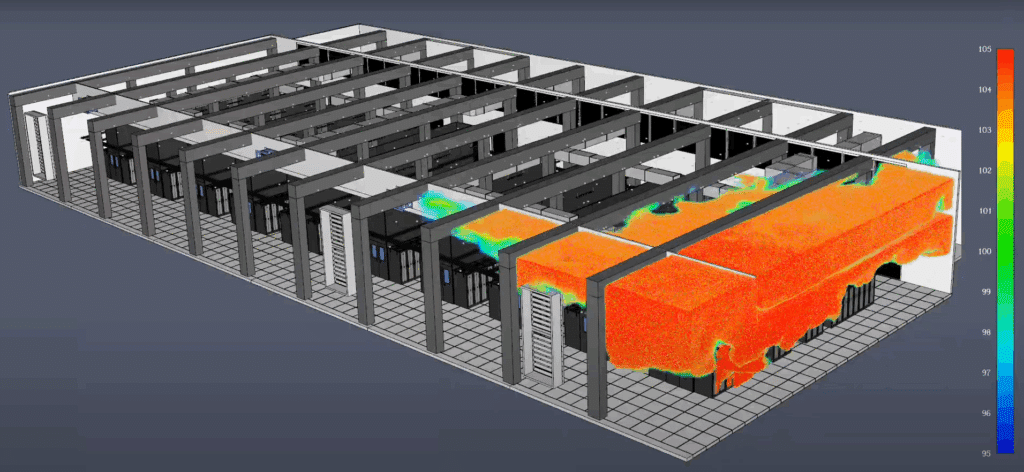Engineering smoke extraction in a data center
Engineering smoke extraction in a data center
Year
2025
Customer
NC
Location
Warsaw
Typology
Data Center - Smoke extraction
Home » Data Center » Data Center Fire Simulation » Engineering smoke extraction in a data center
Smoke control and fire safety in a data center: study of a data hall
Understand the regulatory and technical specifics of a high-density data hall
As part of the construction of a new data center, a major player in the sector called onEOLIOS ‘ expertise for a smoke extraction study aimed at assessing the safety conditions for those involved in the event of afire in a computer room.
This data center, designed to accommodate several hundred high-density IT racks, presents critical fire safety issues. The project is part of a demanding regulatory context, where the protection of people and the continuity of service of digital infrastructures must coexist. Although the site is not classified as an ERP, the safety of those involved, particularly firefighters, remains a fundamental issue.
The study commissioned from EOLIOS had two objectives:
- Validate the ability of the smoke extraction system to re-establish tenable conditions for emergency response in the event of a fire in a room full of computer bays.
- Identify any areas of temporary inaccessibility, in relation to the location of the fire, propagation conditions and smoke extraction behaviour.
Fire and smoke control in data centers: understanding the right strategy for IT rooms
Fire in ventilated technical environments: a specific approach
EOLIOS was commissioned to carry out a smoke extraction study for a high-density data center project, where the risks associated withfire could not be dealt with using a conventional approach. The hall analyzed, representative of the other rooms in the building, is designed to house around 400 computer bays, representing a total thermal load of over 4 MW, fully dissipated by a cooling system using air blown into the technical gallery.
This level of power, combined with the density of the layout, implies a high concentration of combustible materials, heat sources andair circulation, in a space that is both compartmentalized and highly technical.
Guaranteeing firefighter safety: tenability study
Unlike a building open to the public, the building is not intended to be permanently occupied. However, the applicable safety regulations require that conditions for firefighting operations be guaranteed, particularly in terms of visibility, temperature and heat radiation.
This requirement applies in the absence of an automatically-triggered smoke extraction system: activation remains voluntary, carried out on site after evaluation by the emergency services. The system must therefore be capable of restoring favorable conditions even if thefire has already started.
The problem to be solved thus involved identifying the critical configurations of a localized or propagated fire, and assessing the capacity of the smoke extraction system to evacuate smoke without aggravating the çcombustion. It was necessary to understand when and under what conditions an intervention could be envisaged, while taking into account the behavior of the technical installations, in particular the recycling of air by the fanwalls, the role of the supply plenum, and the geometry of the building.
The simulation also had to take into account the effect of sprinklers, which although effective in limiting fire spread, may not be sufficient to guarantee sufficient visibility or to rapidly lower ambient temperatures.
In short, the aim was not only to validate the sizing of the smoke extraction and rescue systems, but above all to understand their actual dynamics in a complex environment, in order to provide the client and the supervisory authorities with a precise and well-founded vision of the site’s safety.
CFD simulation of a data hall fire
Creation of a realistic model adapted to data center configurations
To meet the objectives of the study and provide a realistic and predictive view offire phenomena in the data hall, EOLIOS implemented an approach based on numerical fluid dynamics simulation. The tool used for this mission,
The first stage of the work consisted in building a 3D model faithful to the actual geometry of the room, integrating all the elements influencing the flow. The model took into account the partitioning of aisles, the precise layout of computer bays, ceiling heights, technical galleries, supply air plenums and return air systems.
Particular attention has been paid to the representation of air handling devices, in this case fanwalls, and to the various air flow points between volumes. Smoke extraction dampers, supply air grilles and fresh air inlets were also represented in the model, in order to assess their role in smoke extraction mechanisms once activated.
The mesh selected for this study enabled us to achieve fine resolution, with over one hundred million active cells, ensuring faithful reproduction of temperature, smoke and velocity gradients.
Identifying potential fire sources
Three fire scenarios have been defined to cover the main critical configurations depending on the position of the focus.
- Scenario A: fire at the start of a driveway
- Scenario B: fire at end of aisle, close to air handling units
- Scenario C: mid-aisle fire
For each of these cases, two variants were studied:
- Non-spreading fire: a single bay on fire
- Fire with propagation: extension to adjacent bays every two minutes and modelling of sprinkler activation
Fire sizing and the role of sprinkler systems
Fire behavior has been realistically represented, based on data from the scientific literature on theignition of computer racks. The thermal power defined corresponds to a representative case of a ventilated fire in a data center environment.
Each simulation was run over a period of several tens of minutes, in order to observe the delayed effects of thefire on the environment, and to assess the impact of smoke extraction being triggered halfway through. This choice of time frame made it possible to analyze both the fire’s build-up phase and the post-sprinkler stabilization phase, with or without smoke control intervention.
Finally, for each scenario, EOLIOS extracted the relevant physical quantities at man-height, namely temperature, visibility, radiant heat flux and airflow velocity. These data were analyzed according to the tenability thresholds recognized by French regulations and international standards, enabling an objective assessment of the feasibility of human intervention in a smoke-filled environment.
Analysis of fire-fighting conditions
Effects of contained fire (1 bay)
The simulations carried out in the context of localized fire scenarios showed that the indoor environment was under control. When only one computer rack is affected by thefire, the heat load remains moderate and thermal effects are limited to the immediate vicinity of the fire. At man’s height, temperatures do not exceed the critical thresholds for intervention with fire resistance, and radiated heat fluxes remain below the limits generally accepted to guarantee the safety of those involved.
Smoke propagation also remains contained in this type of configuration. Thanks to the efficiency of vertical compartmentalization and the presence of underfloor heating, smoke tends to concentrate in the upper layers, forming a stable stratification that has very little impact on traffic areas. The mechanical ventilation system, which is always active, helps to limit the horizontal diffusion of these fumes without creating unfavorable overpressure. As a result, overall visibility is satisfactory throughout most of the plant, including adjacent aisles.
This behavior validates the basic strategy adopted for theorganization of the data hall, namely the channelling of air flows, the partitioning of supply and return zones, and the clear separation between evacuation circuits and potential propagation zones. Under these conditions, emergency services can intervene rapidly without waiting for the smoke extraction system to be activated, which is a major advantage in the event of afire detected at an early stage.
Isotemperature without propagation
The impact of fire propagation on data center visibility and temperatures
When thefire spreads to several bays, either due to the thermal effect or the lack of early detection,response conditions deteriorate significantly. The results illustrate a rapid rise in temperatures in the aisles concerned, reaching over 100°C at man-height in the most unfavorable cases. The spread of the fire locally modifies air flows, particularly in the vicinity of air handling units, which can generate a recirculation effect of hot gases towards the recovery zones.
Iso temperature 100°C
This looping phenomenon creates pockets ofoverheated air in certain areas of the hall, even at a distance from the fire, making it difficult or even temporarily impossible for emergency services to move in without reinforced protection. In addition, the prolonged combustion of several plastic-rich bays generated significant soot production, leading to a rapid drop in visibility below the required thresholds. By the tenth minute, some areas of the hall had become completely opaque, making safe navigation impossible without suitable equipment.
Technical galleries, linked to the main volumes via cable ducts or ventilation ducts, are also subject to temperature rise and progressive contamination by smoke, limiting the possibilities of indirect access to the fire. In such scenarios, smoke extraction must be activated to restore minimum visibility conditions and limit the building‘s thermal build-up.
Plan temperature
Temperature plane without propagation
Effect of smoke extraction systems on fire safety
The simulations confirm theeffectiveness of the smoke extraction system as designed, provided it is triggered manually at the right moment. In the scenarios tested, activation of the smoke dampers from the fourteenth minute onwards initiates a favourable air renewal dynamic, evacuating stagnant smoke and progressively reducing the temperature in circulation zones.
This mechanism acts with a certain inertia, but its effects become noticeable within five to six minutes of being triggered. Layers of hot gases are drawn out through the vents and replaced byfresh air introduced from lower levels or buffer zones, helping to restore accessible volumes at ground level. This not only improves visibility, but also reduces thermal pressure on sensitive structures and materials not yet affected by the fire.
Visibility plan
Coupled with the sprinkler system, which limits theheat intensity of the fire, smoke extraction stabilizes the situation and opens up a window of opportunity for emergency services. The simulations show that the combination of these two technical systems can restore a tenable atmosphere in most of the data hall within a few minutes, even in the event of initial propagation, confirming the importance of fine coordination between detection, extinguishing and extraction to guarantee effective fire management in this type oftechnical environment.
EOLIOS' contribution: fire safety expertise for data centers
Digital tools for fire performance
When faced with environments as specific as energy-dense computer rooms, conventionalfire analysis tools quickly show their limitations. For this project, EOLIOS was able to implement advanced modeling to accurately represent the real effects of a fire in a modern data hall. The use of FDS software, coupled with full 3D modeling of the site, enabled us to simulate scenarios that were both representative and usable, integrating the complex interactions between supply devices, compartmentalization, air recirculation and smoke extraction.
Cool and warm air temperature isolation
In addition to modeling, EOLIOS structured thestudy so as to provide clear indicators: temperature, visibility, thermal radiation, conditions of tenability, etc. Each parameter was analyzed at human height, with particular attention paid to the thresholds admissible for prolonged human intervention. This pragmatic approach, focused on operational needs, enables us to assess not only the intrinsic performance of our installations, but also their efficiencyin real-life situations.
A clear, reliable approach that can be leveraged with the authorities
Thestudy also stood out for its ability to unite project stakeholders around a shared understanding of the issues at stake. The results were presented in the form of illustrated reports,video extracts from the simulations and spatio-temporal maps, facilitating their appropriation by the project owner, operators, control offices and fire and rescue services. This technical pedagogy is one ofEOLIOS‘ strengths, combining methodological rigor with the ability to makeinformation intelligible and directly usable.
Lastly, this study is a valuable tool for dialogue with the administrative authorities. It demonstrates that the site not only complies with regulatory requirements, but has also been the subject of a voluntary approach toanticipating andoptimizing fire risk. In this sense, it goes beyond a simple design validation to reflect resilience, performance and technical responsibility. It is precisely this kind ofapproach thatEOLIOS intends to promote alongside its customers in the data center sector and elsewhere.
Find out more:
Video summary of the study
Summary of the study
Thesmoke extraction study carried out by EOLIOS for a high-density data center aimed to guarantee the safety of those involved in the event offire, and to validate the performance of the protection systems. Using CFD modeling (FDS ) and a detailed 3D model, several scenarios were simulated, integrating the effects of sprinklers, smoke extraction and the technical characteristics of the site.
The results show that, for a fire localized to a bay, conditions remain generally tenable(temperature, visibility, radiation). On the other hand, in the event of propagation, visibility drops rapidly, temperatures exceed critical thresholds and certain areas become inaccessible.
L’controlled activation of the Smoke extraction, especially when coupled with sprinklers, can restore favorable conditions after just a few minutes, opening up a window of opportunity for rescue operations.
Beyond simulations, thestudy produced clear indicators (tenability, heat flows, stratification) and supports educational (videos, maps), facilitating dialogue with project owners, operators and authorities.
This approach illustratesEOLIOS to combine scientific rigor and technical pedagogy, offering an operational vision of fire risk. It goes beyond simple regulatory validation to embrace resilience, performance and responsibility.
Video summary of the mission
Discover other data center projects
Engineering smoke extraction in a data center
External & internal CFD – Data Center Hyperscale
CFD Optimization – Data Center
Data Center – DC28 – Internal
Pressure loss study – Generator – Data center
Data Center – PA 22 – External
Technical premises – Data Center
Cooling optimization – Data Center
Data Centers – DC15.1 & DC15.2 – External
Data Center – Paris
Data Center – GAZ NOVEC
Data center – DC25 – Internal
Data center – DC17 – Internal
Data Center – DC10 – Internal
Data center – DC25 & DC26 – External
Data center – D14 – External
Data center – DC17 – External
DC23 – External

